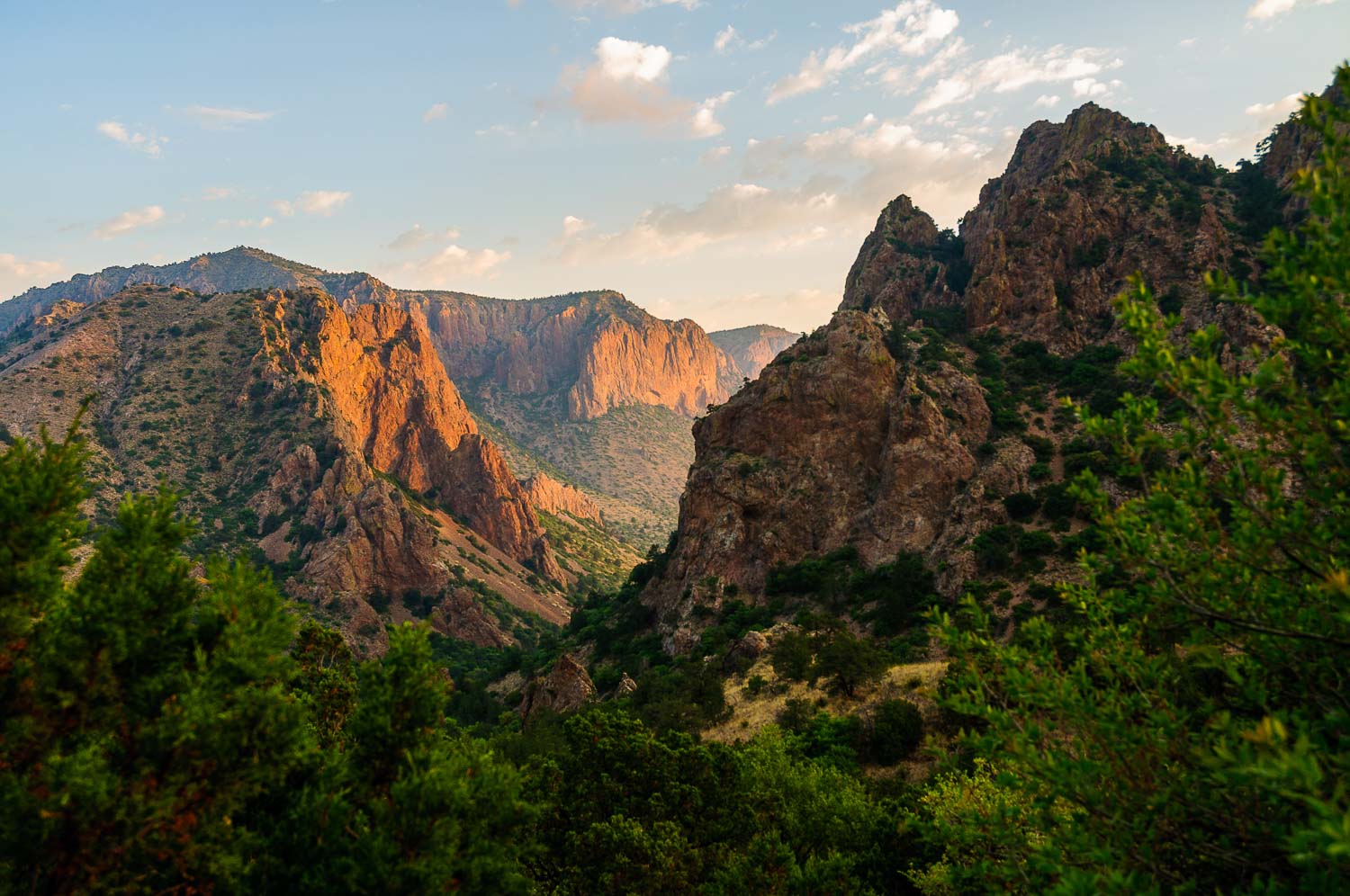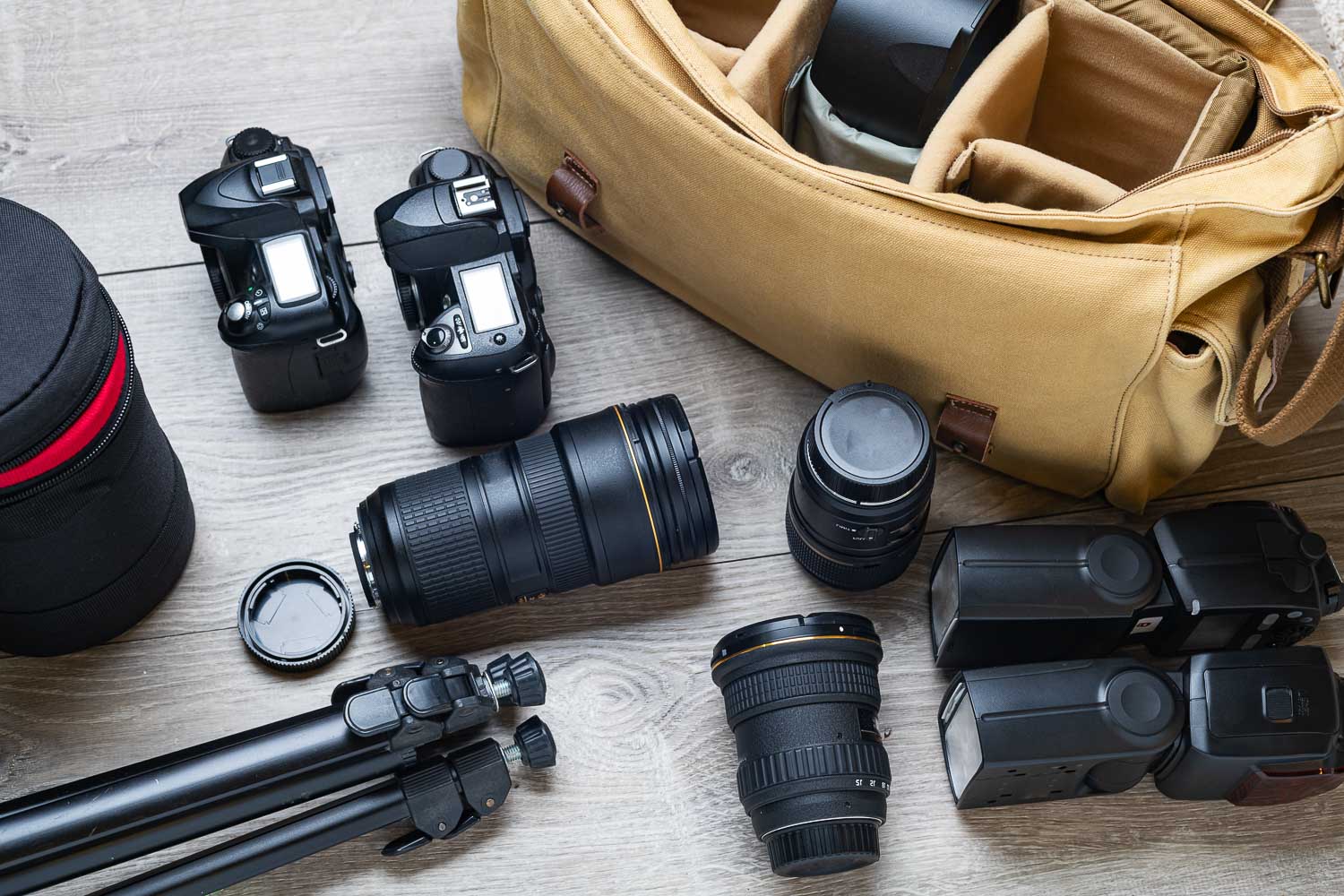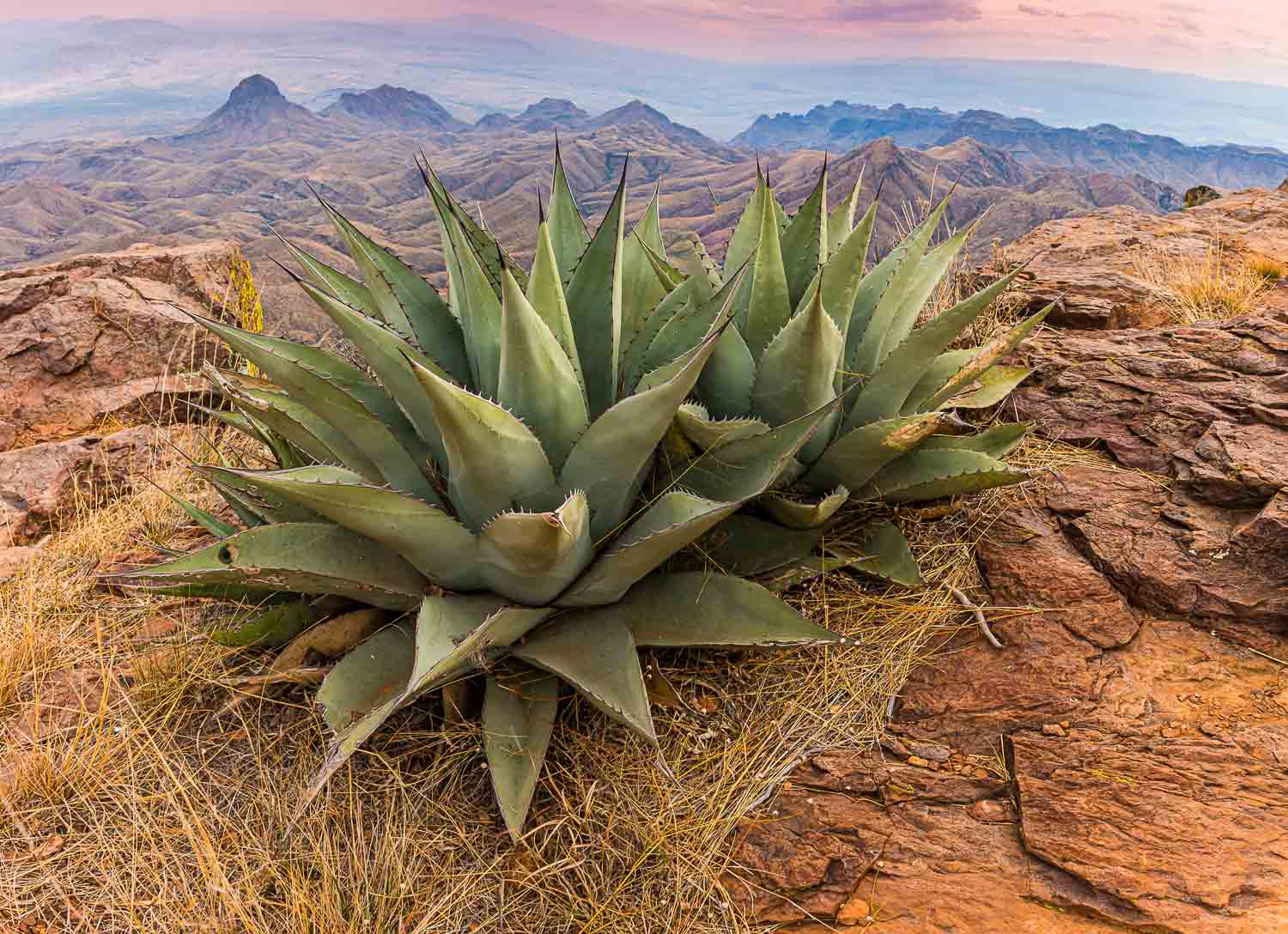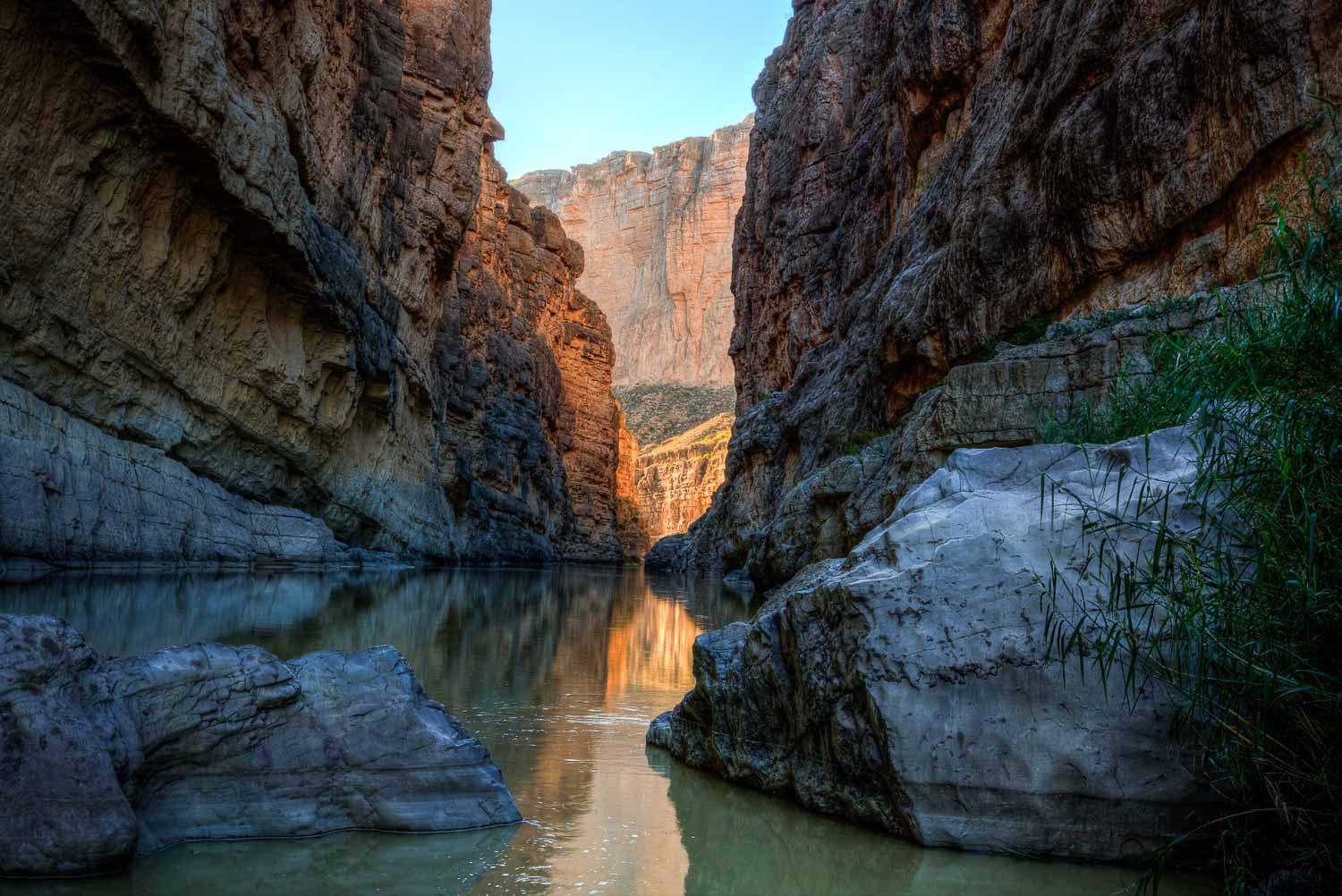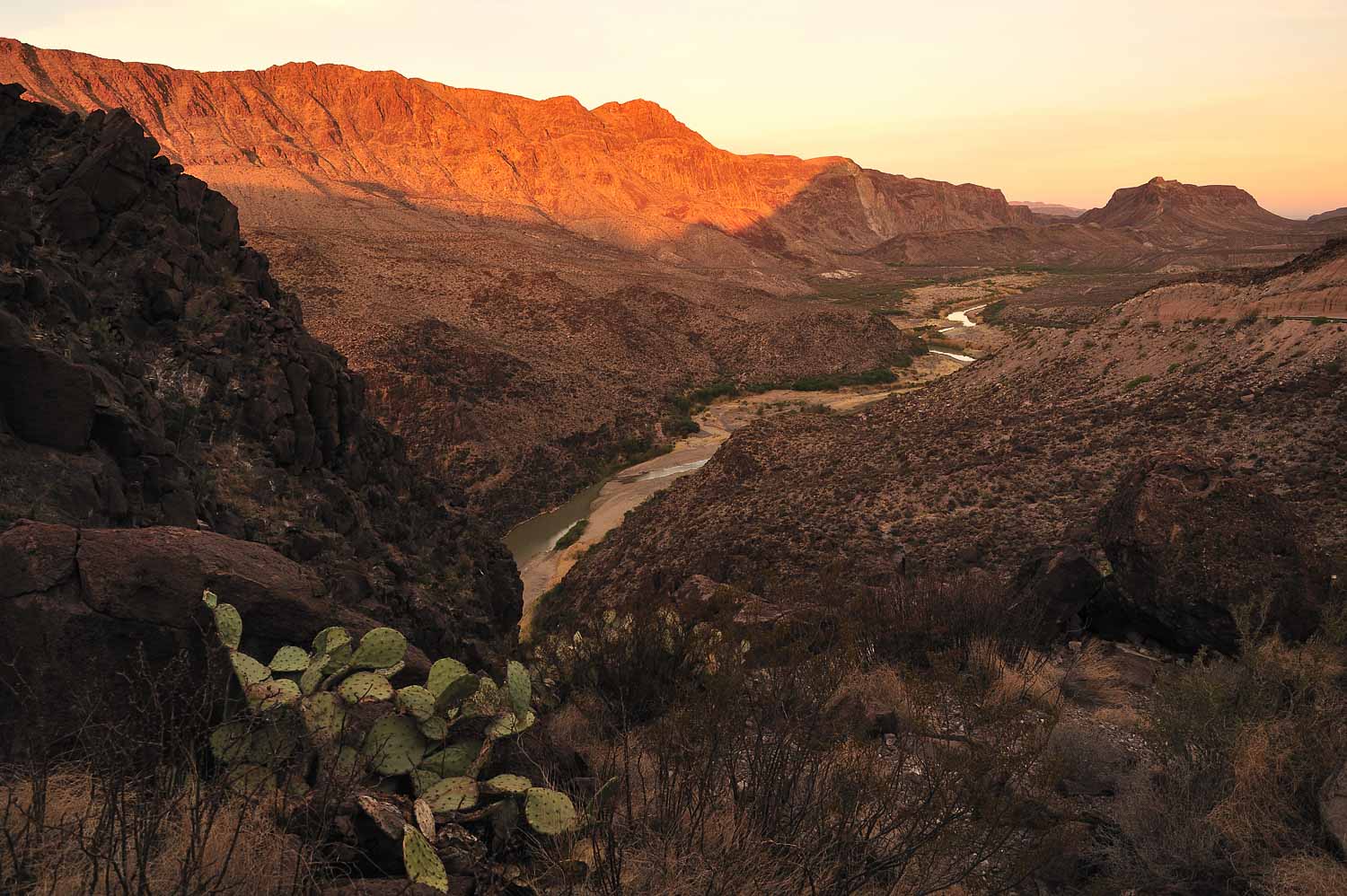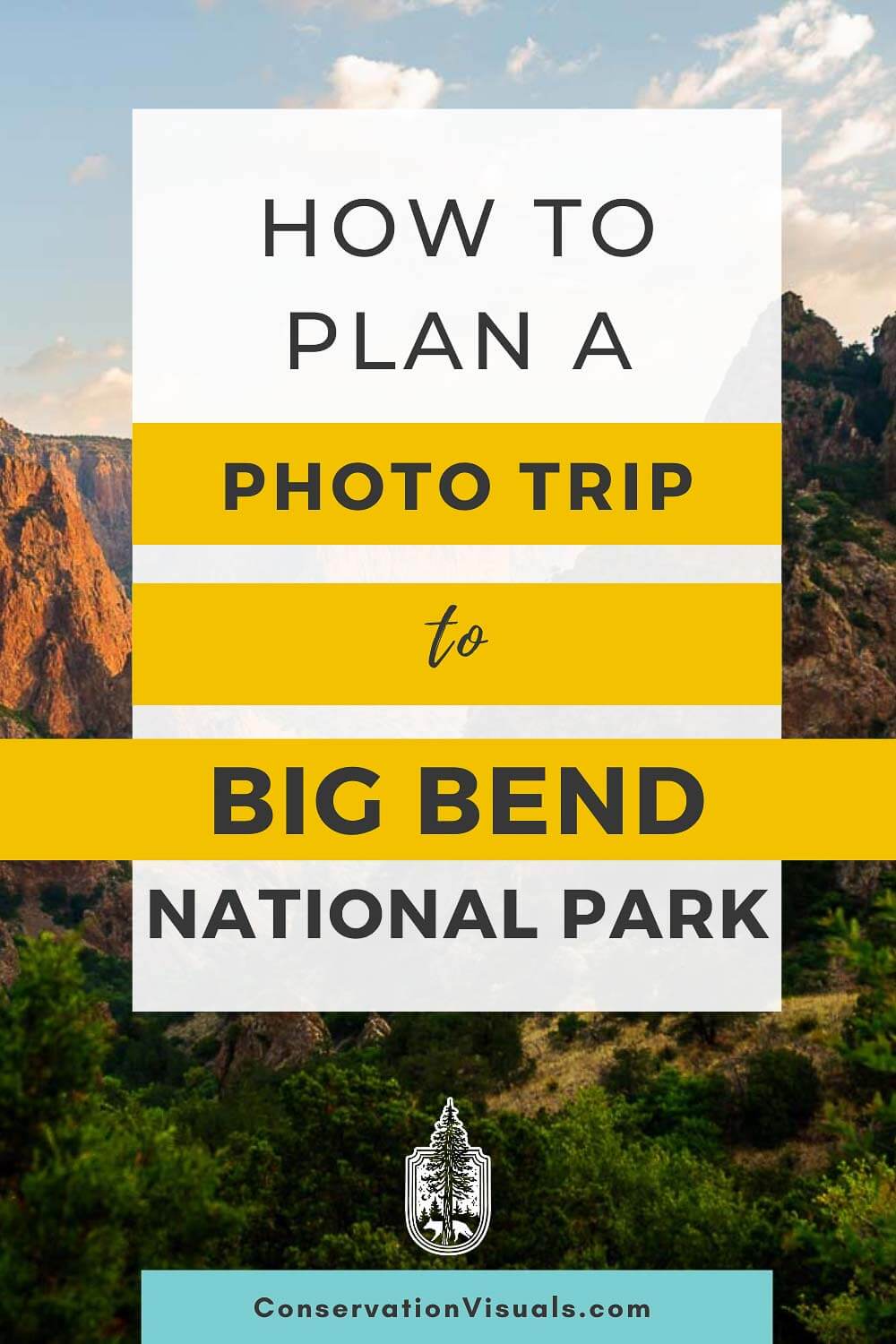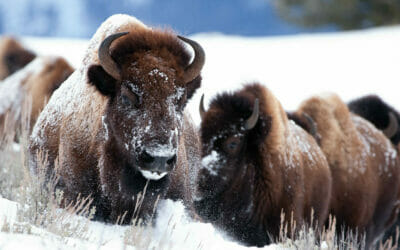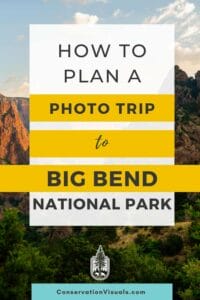Read Time: 18 minutes
As the saying goes “everything is bigger in Texas” and that includes its national parks. At over 800,000 acres Big Bend National Park is one of the largest in the United States.
Located in southwest Texas along the border with Mexico, Big Bend with its diverse landscapes, historic structures, and stunning vistas offers photography opportunities about as vast as the views!
And those views don't end when the sun goes down. Big Bend National Park is also internationally recognized for its exceptionally dark skies, making it one of the premier locations in North America for night sky photography and astrophotography.
So whether you're making your way to West Texas to snap shots of the earth or of the sky above, we've got you covered when it comes to finding the best photography spots at Big Bend National Park!
Contents
- Choosing your trip dates
- What to wear
- Photography gear to pack
- Safety considerations
- South Rim
- Santa Elena Canyon
- Hot Springs Historic District
- Mule Ears Spring Trail
- Balanced Rock
- Ross Maxwell Scenic Drive
- Emory Peak
- Boquillas Canyon
- Lost Mine Trail
- Rio Grande Village
- Where else to visit while you're in West Texas
Choosing your trip dates
Big Bend National Park with its breathtaking views and endless opportunities to capture great photos offers an unforgettable experience no matter the season.
Springtime unveils a desert in bloom, with vibrant wildflowers carpeting the landscape, while summer brings dramatic thunderstorms and arresting sunsets.
As the summer heat subsides, autumn offers a cool, soothing palette while winter's softer light brings out the textures and contrasts of the landscapes.
There's always a perfect time to capture the sweeping views of one of our favorite places. Whether you're visiting during the height – and heat! – of summer or to capture the colors of autumn, be prepared for seasonal variations so that you can plan accordingly.
Here's an overview of what to expect during each season:
Spring (March through April)
Spring is a perfect time to explore and photograph Big Bend National Park before the summer heat sets in. You'll witness a breathtaking transformation as the park blooms with a plethora of vibrant wildflowers that create a picturesque carpet of color against the backdrop of the rugged Chisos Mountains.
Keep an eye on the weather forecast and your camera handy.
Occasional spring showers not only lead to beautiful blooms but can also result in dramatic cloud formations, clearing storms, and sometimes, even rainbows!
From the desert floor to the heights of the South Rim, spring in Big Bend National Park offers some of the very best photography opportunities.
Pros:
- Spring blooms provide a colorful and vibrant contrast to the more arid, rugged landscape.
- Mild temperatures allow for comfortable exploration and extended photo sessions.
- Occasional spring showers can cause some pretty rad cloud formations you'll for sure want to shoot.
Cons:
- Some parts of the park may be inaccessible due to flooding from rain storms.
- Don't forget to pack your antihistamine of choice as the pollen from blooming plants can trigger allergies.
Summer (May through August)
As we move into the summer, Big Bend National Park transitions from a spring wonderland into a sun-soaked landscape. The scorching heat creates mirage effects over the desert sands and the mountains, leading to some – dare I say – “hot” shots. Plus, the South Rim becomes an amphitheater of starry skies as the summer nights unveil the Milky Way in all its glory.
While the summer months provide access to some of the best photography spots in Big Bend National Park, show up prepared to endure temperatures that can soar above 100°F.
While temperatures drop to a more comfortable range at night, we can't emphasize enough just how extreme that summer heat is.
Pros:
- During the summer months, the Milky Way's densest star cloud, the Galactic Center, is visible, and it rises high in the sky, creating a surreal scene. Long exposure shots during this time can capture the Milky Way's brilliant details and colors.
- Late summer brings the monsoon season, with dramatic cloud formations and lightning storms that add drama and depth to your photographs.
- The intense summer heat creates mirage effects that can result in unique photos.
Cons:
- The extreme heat of summer can not only be uncomfortable, but it can also be dangerous. Be prepared with sun protection and plenty of water.
- Not only can the heat present health risks to you, it can also damage photography equipment.
Photo: Wisanu Boonrawd/Shutterstock
Big Bend is a dream location for night sky photography. From star trails to crisp Milky Way photos, plan to stay up into the wee hours capturing shots of the clear dark skies.
Autumn (September to November)
Autumn in Big Bend National Park ushers in milder temperatures and changing colors, bringing about some of the best photography opportunities. The temperatures during this time are more pleasant, often ranging from the mid-60s to 80s, making it an ideal time to explore and photograph. Nights can become quite cool, at least relative to the summer heat.
Autumn also brings with it clearer skies and excellent light conditions for capturing the natural features of the park's landscapes. The Chisos Mountains take on a different character with the changing light and with the park adorned in fall colors.
Pros:
- The mild temperatures of autumn provide a much awaited respite following the extreme summer heat.
- The fall colors provide a breathtaking, unexpected colorful element to your photographs.
- Clearer skies and excellent light conditions enhance shots of the park's landscapes.
Cons:
- Beautiful autumn colors and mild weather often attract a large number of visitors, especially during holiday weekends.
- Unpredictable weather transitions between summer and winter can sometimes lead to sudden rainfall or cold snaps.
Winter (December to March)
Winter brings an unmatched tranquility to Big Bend National Park.
During this time, temperatures can vary significantly with daytime highs averaging around 60°F and nighttime lows often dropping below freezing. Though temperatures can be chilly, they're comfortable enough for getting to your favorite photography spots.
Winter in Big Bend National Park presents a unique chance to photograph the park's bare, stark scenery against the backdrop of clear, crisp skies. The clarity of the winter skies at night makes the South Rim a night sky photographer's paradise.
If you're lucky, a dusting of snow on the Chisos Mountains can give the typically hot, desert landscape, a winter-y vibe.
Pros:
- Free from the hustle and bustle of large crowds, the tranquility of the park during winter provides a serene environment.
- Clear, crisp winter skies provide perfect conditions for astrophotographers to capture Orion Nebula and the Andromeda Galaxy, particularly from the South Rim.
- Snowfall, although rare, can transform the landscape into a winter wonderland.
Cons:
- Certain trails and roads may be closed or difficult to navigate due to ice or snow, limiting access to some photography spots.
- Equipment may need special care or protection due to cold weather conditions.
Photo: SAG stock/Shutterstock
Your clothes are as important as your photography gear! Consider the season and weather to stay safe and comfortable.
What to wear
Dressing appropriately is crucial for a comfortable and safe photography adventure.
No matter the season at Big Bend National Park, you'll need to pack sturdy, comfortable hiking boots and serious sun protection – a wide-brimmed hat, UV-protection sunglasses, and high-SPF, sweat-resistant sunscreen.
Here are a few other things to consider when packing for your trip:
VISITING BIG BEND IN THE SPRING
With day temperatures that can climb to 80°F and cooler nights, you're going to need a range of clothing options to keep you cool as the day warms up and warm as the night cools down. We've said it once, we've said twice – layering is key!
- Start with a lightweight moisture-wicking base layer to keep sweat off your skin and to keep you cool as the day heats up
- Fleece mid-layer or lightweight down jacket to provide insulation and warmth during cooler early mornings and evenings
- Breathable water- and wind-proof jacket to protect you at windy higher elevations and from unexpected spring showers
- Waterproof pants that not only keep you dry, but are also sturdy enough to protect your legs from prickly pear cacti
VISITING BIG BEND IN THE SUMMER
Summer in the Big Bend National Park is a hot affair with daytime temperatures regularly exceeding 100°F and a UV index that is, well, sizzling. Pack light-colored, moisture-wicking clothing for daytime exploration, but also bring along a warmer layer for when the sun sets and the temperature cools.
- Lightweight, moisture-wicking clothing to keep you cool and dry, ideally with a sun protection factor
- Even though it's summer, having a lightweight, long-sleeved shirt and pants can protect your skin from the strong sun rays, insect bites, and cacti
- Warmer top to keep you cozy during the night and in the early morning
- Packable rain jacket for surprise summer storms
VISITING BIG BEND IN THE AUTUMN
Autumn expeditions to Big Bend National Park greet you with relatively mild daytime temperatures hovering around 80°F and cooler evenings that often dip to a crisp 50°F. Just as you would expect, the key to comfortably navigating this transitional weather is – you guessed it – strategic layering!
- Begin with a breathable, moisture-wicking base layer to keep you cool and dry during the day
- As the sun sets and temperatures fall, add a fleece mid-layer or lightweight down jacket
- Water- and wind-proof jacket to keep you warm, dry, and protected
- Coat or heavier jacket for extra warmth as necessary
VISITING BIG BEND IN THE WINTER
During winter at Big Bend National Park daytime highs average around 60°F with nighttime lows often dropping below freezing. To ensure comfort and warmth during your winter photography adventure, being prepared for these fluctuations is crucial.
- Begin with a thermal, moisture-wicking base layer to keep you dry and insulated
- Add a mid-layer like a lightweight down jacket or fleece to trap body heat
- Carry an outer layer like a wind- and water-resistant winter coat to shield against icy winds, snow, or rain
- Warm and waterproof footwear, preferably insulated boots
- Pack thermal hats, gloves, and scarves to keep you extra warm!
By dressing appropriately for the season, you'll be ready to catch all the amazing shots from the best photography spots in Big Bend National Park!
Recommended: We list a few of our top recommendations for clothing for outdoor photographers in this gift guide (which makes a handy wishlist if anyone asks you what you want for a birthday or holiday!)
Photo: Kosoff/Shutterstock
Consider what you primarily want to photograph – whether that's wildlife, landscapes, plants, the night sky and so on – to help you decide what camera gear you want to pack.
Photography gear to pack
Equipping yourself with the right gear is essential for capturing your very best Big Bend National Park photos. Whether you're a seasoned pro or an enthusiastic beginner, our recommendations will help you create stunning images during your Big Bend NP photo expedition.
Camera Body
When it comes to picking the right camera body, it's all about what feels right for you and aligns with your budget. You might lean towards a DSLR or maybe you're more into the mirrorless scene (we've got a handy DSLR vs. mirrorless comparison here for your perusal).
But here's a pro-tip – always go for something sturdy and weather-sealed, because Big Bend National Park is as unpredictable as it is beautiful!
Lenses
Having a variety of lenses on hand will allow you to capture all aspects of Big Bend National Park – whether up close or from a distance. Consider bringing the following:
- Wide-Angle Lens (14-35mm): This lens is your go-to for framing the vast, sweeping vistas of Big Bend National Park.
- Standard Zoom Lens (24-70mm): A versatile tool for everyday photography needs, this lens is perfect for capturing a variety of scenes from different distances.
- Telephoto Lens (100-400mm or more): This lens is essential for safely photographing wildlife from afar, ensuring you respect their space while achieving impressive detail.
- Macro Lens: This lens shines when it comes to detailed close-ups, enabling you to capture vibrant wildflowers and intriguing textures in high definition.
Remember to pack your camera lens hoods, too – they're an underrated and utterly essential tool for high-quality photos.
Check out our guides to the best landscape lenses and the best wildlife lenses to help you make gear decisions.
Tripod
When it comes to taking jaw-dropping sunrise and sunset shots, or mastering those long-exposure night sky photos, you can't go wrong with a solid yet lightweight tripod. Trust me, it's a lifesaver in low-light conditions and a game-changer for getting that perfect, sharp shot.
Go for a lightweight, sturdy tripod with adjustable legs and a ball head. It'll give you the flexibility to set up shop on all sorts of terrains.
Filters
Okay, let’s talk about lens filters. These bad boys can really elevate your photos and keep your precious lenses safe from harm.
Here's a quick rundown of the ones you might want to consider:
- Circular Polarizing Filter: This is like the cool sunglasses for your camera! It reduces glare, gives you those deep blue skies, and makes the colors in your landscape shots pop. It's a must-have for any outdoor photography trip.
- Neutral Density Filter: Think of this as your magic tool for creating those surreal, dream-like scenes. It allows for longer exposures in bright conditions, turning raging rivers into silky streams and giving clouds that smooth, streaking effect.
- UV Filter: It might not drastically change your images, but it's worth its weight in gold when it comes to protecting your lens from scratches and dust. Plus, it helps to reduce haze in your shots, giving you crisp and clear images. It's like a safety blanket for your camera lens.
Having the right tools at your disposal can make a world of difference in your photography.
Camera Accessories
Remember these essential accessories to keep your gear protected and functioning smoothly:
- Pack extra batteries, especially during cooler temps.
- Bring multiple high-capacity memory cards.
- Use a comfortable, weather-resistant camera bag or backpack to protect and provide easy access to your gear.
- Lens cleaning supplies, including microfiber cloth, lens brush, and air blower.
Photo: Billy McDonald/Shutterstock
Agave plants are one of the iconic species you can photograph in this arid landscape, like these agave on the South Rim.
Safety considerations
While Big Bend National Park offers unparalleled photographic opportunities, it's essential to take care of yourself. Be prepared, stay hydrated, and prioritize safety while exploring.
Wildlife Safety
Big Bend National Park is a haven for a diverse range of wildlife. Notable among these are nearly 450 species of birds, including the Colima Warbler and the Mexican Jay, over 50 species of reptiles including the iconic Western Diamondback Rattlesnake, as wells as Mexican Black Bears, Mountain Lions, and smaller mammals like the Desert Cottontail, White-nosed Coati, and Javelina.
Remember to observe from a safe distance and adhere to the following guidelines:
- Follow park rules (and logic) by staying at least 100 yards away from predator species, and 25 yards away from smaller animals.
- Use a telephoto lens to capture close-up images of wildlife without encroaching on their territory or disturbing their natural behavior.
- Never feed wild animals. It's dangerous for both you and them. Plus, it's illegal in the park.
- Be bear aware by carrying bear spray, making noise as you walk, and following proper food storage guidelines.
- Be familiar with ethical wildlife photography guidelines. Check out our ethics guide for reference.
Weather and Terrain Safety
Big Bend National Park's vast landscapes are breathtakingly beautiful but can be challenging to navigate, plus weather conditions can be unpredictable, fluctuating between extreme heat during the day and cold at night.
Follow these tips to ensure you're safe and prepared:
- Hydration is critical in the summer heat, so carry a large water bottle and/or hydration pack. The park's dry heat can dehydrate you quickly, and staying hydrated vital.
- Dress in layers and bring suitable clothing for the season and potential weather conditions.
- Be realistic about your physical abilities. Only attempt hikes or climbs that are manageable and safe for your skill level.
- Check the weather forecast so you're aware of any incoming storms or extreme temperatures. Adjust your plans accordingly.
General Safety Tips
Lastly, keep these general safety tips in mind while exploring Big Bend National Park:
- Let someone know your itinerary, including planned routes and expected return time.
- Cell service is limited in the park, so bringing a map, compass, and/or GPS device will help you navigate and avoid getting lost.
- Follow Leave No Trace principles to preserve the beauty of Big Bend and respect National Park Service rules and regulations.
By keeping these safety considerations in mind, you can enjoy your Big Bend National Park photography adventure with confidence and peace of mind.
Photo: Zack Frank/Shutterstock
Panoramic views await you in this diverse and spectacular national park!
Our 10 favorite locations for photographing Big Bend National Park
Now, let's dive into the good stuff — the top photography spots in Big Bend National Park.
Central to the park are the Chisos Mountains, the only mountain range fully contained within a U.S. national park boundary. The mountain range beckons with its majestic peaks and valleys and while their awe-inspiring beauty presents countless opportunities to capture breathtaking panoramas, there's so much more to the park.
Big Bend National Park offers a plethora of stunning landscapes, each with their unique charm. From easily accessible vistas to remote wilderness trails, these locales offer opportunities to photographers of all skill levels!
South Rim
Best for:
Hiking, landscape photography, and night sky photography
Why we love it:
Arguably the most iconic location in Big Bend National Park, the South Rim offers no shortage of jaw-dropping-ly beautiful views.
The vastness of the distant desert vistas taken in through your camera lens as you make your way through the South Rim Trail is, at times, difficult to fully comprehend. Visitors can access the trail either via the more challenging Pinnacles Trail or the more relaxed (as relaxed as a hot mountain hike can be) Laguna Meadows Trail.
And, for night sky enthusiasts, the South Rim provides an elevated vantage point, coupled with the vast open sky, allowing for unparalleled views of the cosmos.
Photo tips & ideas:
- Use a wide-angle lens to fully capture the expansive views of the vast desert expanse.
- Try long exposure photography to capture stunning star trails or the Milky Way.
- To make your images pop, try using a polarizing filter. This will deepen the blue of the sky, increase contrast in the clouds, and minimize glare from the sun.
- Incorporate interesting foreground elements like rocks, plants, or cacti that enhance the desert atmosphere of your images.
Photo: Rowdy Winters Photography/Shutterstock
Spectacular colors and impressive rock formations are shown off in the afternoon light at Santa Elena Canyon.
Santa Elena Canyon
Best for:
Dramatic canyon views, river shots, bird watching, and sunset and sunrise photography
Why we love it:
Located in the western area of the park, the majestic Santa Elena Canyon is situated where the Rio Grande takes a sharp turn, creating a spectacular natural border between the USA and Mexico.
The vertical walls of the canyon reach up to 1,500 feet, catching the light to create a beautiful interplay of colors and shadows that transform throughout the day, while the serene water beautifully reflects the sky and canyon walls.
For a more immersive experience, consider renting a canoe or kayak to explore the Rio Grande River to capture shots of the canyons and cliffs from the river.
Photo tips & ideas:
- Try long exposure shots of the Rio Grande for a serene and dreamy effect.
- Experiment with different compositions, including reflections on the river in your shots.
- Consider shooting at different times of day to capture the changing light and shadows on the canyon walls.
- Capture shots of the river bend that spark curiosity, making viewers think, “But, what's beyond the bend?”
Photo: William Silver/Shutterstock
An abandoned post office in the Hot Springs area is one of the interesting ruins to check out.
Hot Springs Historic District
Best for:
Historic structures, hot springs, and rock art
Why we love it:
The Hot Springs Historic District offers a glimpse into the past with its preserved hot springs, building remnants, and artifacts from early settlers.
The area features several short trails that take visitors through various terrains, including wetlands, desert landscapes, and along the Rio Grande and, at 105°F, the spring itself is the perfect spot to post up for a bit and take in the scenery while planning out your shots.
A two-mile long gravel and dirt road takes visitors to the Hot Springs Historic District and Hot Springs Trail trailhead.
Photo tips & ideas:
- Capture the historic charm of the district by including the bathhouse ruins or other buildings in your shots.
- Take advantage of the variety of terrain to capture diverse images, such as wetland scenes or desert landscapes.
- Play with different perspectives, like shooting from a low angle to emphasize the historic buildings against the vast desert landscape.
- Don't be afraid to get creative and experiment with black and white photography for a vintage feel.
Mule Ears Spring Trail
Best for:
Hiking, landscape photography, and wildlife photography
Why we love it:
The 3.8-mile Mule Ears Spring Trail takes you through rugged desert landscapes with the iconic Mule Ears peaks in the distance, washes with cottonwood trees, past a historic rock corral until you reach the Mule Ear Spring – a lush little oasis with maidenhair ferns and cattails in the middle of the desert.
At the spring you'll have a chance to capture macro shots of the dragonflies and leopard frogs that call this area home.
The namesake themselves, the Mule Ears peaks, cast a striking silhouette against the desert sky creating an enchanting vista, making this spot a must-visit for anyone photographing Big Bend National Park.
Photo tips & ideas:
- Use a telephoto lens to capture close-up shots of the Mule Ear peaks or birds, deer, or javelinas.
- Play with different angles and perspectives to incorporate the winding trail into your shots.
- Use a wide-angle lens to capture the expansive desert landscape with the Mule Ears rock formations in the background.
- Incorporate the diverse elements like the greenery of the spring and the arid desert into a single shot.
Photo: jordaneil/Shutterstock
Balanced Rock is one of the must-see rock formations so well known in the park.
Balanced Rock
Best for:
Landscape photography, rock formations, and bird watching
Why we love it:
Balanced Rock, a massive boulder precariously perched atop a delicate rock pedestal, is quite the sight.
The short but rugged 0.3-mile Grapevine Hills Trail to Balanced Rock takes you through stunning desert landscapes, winding its way through sandy washes and rocky terrain, providing excellent opportunities for unique compositions and shots.
Some of the beauty of this location is that the lighting and shadows change throughout the day, providing endless possibilities for capturing different moods and perspectives.
Photo tips & ideas:
- Experiment with different angles and perspectives to capture the balance and unique shape of Balanced Rock.
- Consider visiting during golden hour for beautiful lighting on the rock formation.
- Capture the expansive desert landscapes by using a wide-angle lens or panoramic shots.
- Look out for bighorn sheep and javelinas to add an interesting element to your photos.
Ross Maxwell Scenic Drive
Best for:
Sunset photography, landscape photography, and road trip photos
Why we love it:
Ross Maxwell Scenic Drive is a 30-mile paved road highlighting the rugged and diverse landscape of Big Bend National Park, offering breathtaking views of the Chisos Mountains leading to Santa Elena Canyon.
With multiple lookout points and pull-offs along the way, including Sotol Vista Overlook, Sam Nail Ranch, and Old Maverick Road, you can easily stop and capture photos of the ever-changing scenery.
Aside from the scenic views, keep an eye out for desert bighorn sheep, roadrunners, and other animals that may cross your path.
Photo tips & ideas:
- Take advantage of the many lookout points and pull-offs along the drive for different perspectives and compositions.
- As night falls, you can capture long exposure photos of the winding road with stars twinkling in the background.
- Capture the oranges and pinks of the sky during sunset to create a vibrant backdrop for landscape shots.
- Use the different geological features, such as canyons and cliffs, to add depth and interest to your photos.
Photo: drewthehobbit/Shutterstock
It may seem like arid, rugged landscapes, but delicate beauty is found here as well, such as in these flowers blooming along the Mule Ears Spring Trail.
Emory Peak
Best for:
Hiking, landscape photography, and adventure photography
Why we love it:
At 7,825 feet, Emory Peak is the tallest point in Big Bend National Park with stunning panoramic views of the surrounding Chisos Mountains.
The hike to the summit is a challenging but rewarding experience where along the way you'll encounter diverse flora and fauna, including cacti and various bird species. And, as you reach the summit, you'll be rewarded with breathtaking views of the Chisos Basin and beyond.
This area is a paradise for landscape photographers, offering sweeping views as you move through the elevation changes.
Photo tips & ideas:
- Bring a wide-angle lens to capture the expansive views from the summit.
- Use different elevations along the trail to create layers in your photos.
- Use the changing light throughout the day also adds depth and interest to your photos or consider visiting during sunrise or sunset for dramatic lighting and colors in your photos.
- Be prepared for a challenging hike, wear proper footwear, and stay hydrated while on the trail.
Boquillas Canyon
Best for:
Hiking, landscape photography, and cultural photography
Why we love it:
Boquillas Canyon offers a unique blend of natural beauty and cultural experiences. The 1.4-mile Boquillas Canyon Trail takes you through the narrow canyon walls, with towering cliffs on either side.
While the changing colors of the rock formations throughout the day provide endless opportunities for stunning landscape photos, what makes Boquillas Canyon truly special is the opportunity to interact with local Mexican residents along the riverbank. This cultural exchange provides a unique perspective for photographers, capturing both the beauty of nature and the warmth of human connection.
Photo tips & ideas:
- Experiment with different angles and perspectives while moving through the canyon.
- Use the changing colors of the rock formations to add interest and depth to your photos.
- Take advantage of the opportunities for cultural photography, capturing both nature and human interaction in one shot.
- Respect the customs and traditions of the local residents and ask for permission before taking photos of them.
Photo: T photography/Shutterstock
Golden hour brings out the spectacular beauty of the landscape, including the snaking curves of the Rio Grande river.
Lost Mine Trail
Best for:
Hiking, landscape photography, and bird watching
Why we love it:
Next, head up to the Lost Mine Trail. This trail, despite its moderate difficulty, rewards hikers with a breathtaking vantage point that provides stunning views of Casa Grande and Juniper Canyon.
During sunrise or sunset the light bounces off the Chisos Mountains, treating you to a colorful display that's perfect for capturing spectacular photographs.
The varying terrain and elevation changes make this trail an excellent location for landscape photography. From rocky cliffs to lush vegetation, there's plenty of opportunities to capture the diverse beauty of Big Bend.
If you're lucky, you may even spot some birds soaring overhead or perched on nearby trees.
Photo tips & ideas:
- Bring a telephoto lens for capturing close-up shots of birds
- Consider visiting during sunrise or sunset for the best lighting and colors in your photos.
- Keep an eye out for interesting patterns and textures in the rocks and vegetation.
- Don't be afraid to get creative with different compositions and angles.
Rio Grande Village
Best for:
Bird watching, landscape photography, and stargazing
Why we love it:
Rio Grande Village is a haven for nature enthusiasts and photographers alike.
Named after the meandering Rio Grande River that flows alongside it, this village offers an blend of lush vegetation and distinct geographical features.
The riparian environment attracts a variety of birds, making it an outstanding spot for bird watching. An elevated boardwalk is available for those who wish to immerse themselves in the village's scenic vitality without disturbing the natural habitat.
Aside from bird watching, Rio Grande Village also offers stunning views of the Rio Grande River and surrounding mountains.
The contrast between the blue waters and desert landscape creates a striking backdrop for landscape photography. And at night, this area is perfect for capturing the Milky Way and other celestial wonders in the dark sky.
Photo tips & ideas:
- Bring a telephoto lens for capturing close-up shots of birds.
- Experiment with different shutter speeds to capture the movement of flying birds.
- Consider renting a canoe or kayak for a unique perspective and closer access to wildlife on the Rio Grande River.
- Visit during sunrise or sunset for dramatic lighting and colors in your photos.
Where else to visit while you're in West Texas
West Texas, while brimming with stunning landscapes and unique cultural experiences, can be somewhat challenging to access. It's a region characterized by vast distances and sparse populations, meaning that it can require quite a bit of time, planning, and driving to explore this area.
Given the commitment required to visit West Texas, make the most of your trip by exploring these other nearby locales:
- Marfa is a tiny desert town with an outsized reputation as a hub of contemporary art, thanks to the Chinati Foundation, and the Marfa Lights, a phenomenon of glowing orbs appearing in the night sky.
- Alpine, home to Sul Ross State University, is known for its vibrant arts scene, charming downtown area, and the Desk Hike — a short, yet steep, trail that leads you up to a school desk sitting atop Hancock Hill.
- McDonald Observatory allows visitors to gaze into deep space through high-powered telescopes. Thanks to its high elevation and the clear, light pollution-free skies of West Texas, it's a paradise for capturing the celestial wonders of the universe.
- Terlingua is a ghost town turned quirky tourist destination with a unique blend of abandoned buildings and vibrant art installations.
While reaching West Texas might require some effort, the payoff is truly worth it!
Recommended: Excited for more national parks to explore with your camera? Check out our guides to Yellowstone National Park and White Sands National Park to get you started on more adventure planning!

